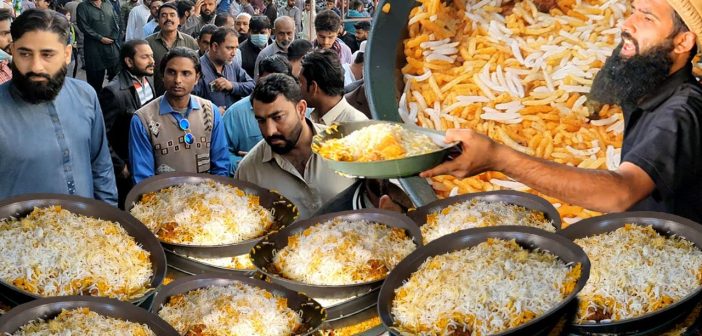In the realm of Indian cuisine, biryani reigns supreme as a symphony of flavors, aromas, and textures. It’s a dish steeped in history and cultural significance, a true culinary icon that unites India’s diverse regions with its irresistible charm. Let’s delve into the captivating story of biryani, its origins, etymology, and the fascinating facts that make it an enduring symbol of Indian culinary heritage.
The Essence of Biryani
At its heart, biryani is a layered rice dish cooked with an array of spices, marinated meat or vegetables, and often adorned with elements like saffron, fried onions, and nuts. However, the true essence of biryani lies in its preparation methods:
- Kacchi Biryani: Raw marinated meat is layered with parboiled rice and cooked together in a sealed pot, allowing the flavors to intermingle slowly.
- Pakki Biryani: The meat is cooked separately, then layered with parboiled rice. Both are then cooked together to achieve a perfect balance of flavors.
The Origins of Biryani: A Culinary Journey Through Time
The history of biryani is shrouded in a delectable mix of theories and legends. Here are the most prevalent views:
- Persian Influence: One widely accepted theory is that biryani has its roots in Persia (modern-day Iran). The word ‘biryani’ itself is derived from the Persian word ‘birian,’ which means ‘fried before cooking.’ It’s believed that the Mughals, who ruled a significant part of India from the 16th to the 19th century, brought biryani with them.
- Homegrown Evolution: Some food historians propose an alternative theory, suggesting that biryani has indigenous origins. They point to ancient Tamil texts that mention a similar rice dish called ‘Oon Soru,’ made with rice, ghee, meat, turmeric, coriander, pepper, and bay leaf. This dish evolved over time, possibly influenced by Persian and Arab traders.
- The Legend of Mumtaz Mahal: A popular legend attributes the creation of biryani to Mumtaz Mahal, the beloved wife of Mughal Emperor Shah Jahan. As the story goes, Mumtaz visited the army barracks and found the soldiers undernourished. She ordered the royal cooks to prepare a wholesome meal with rice, meat, and spices – giving birth to biryani.
The Name and its Meaning
As mentioned, the word ‘biryani’ comes from the Persian word ‘birian’ (fried before cooking). Another related Persian term, ‘birinj,’ meaning rice, further supports the theory of the dish’s Persian origins.
Regional Variations: A Tapestry of Flavors
One of the most captivating aspects of biryani is its endless regional variations. Across India, each state and city boasts its unique biryani style, reflecting local ingredients and cultural influences. Let’s savor a few famous varieties:
- Hyderabadi Biryani: A hallmark of Hyderabadi cuisine, famed for its fiery flavors and kacchi preparation method.
- Lucknowi Biryani: Renowned for its delicate flavors, aromatic spices, and pakki cooking technique.
- Kolkata Biryani: A distinctive creation featuring the subtle flavors of spices and the surprising addition of potatoes.
- Dindigul Biryani (Tamil Nadu): Known for using the flavorful Seeraga Samba rice variety and generous amounts of curd, giving it a unique tang.
- Malabar Biryani (Kerala): A unique coastal variation using short-grained Khaima rice and local spices, often served with coconut-based accompaniments.
Interesting Facts about Biryani
- The Art of ‘Dum’: ‘Dum’ cooking, where the pot is sealed and cooked on low heat, is integral to biryani, allowing the flavors to infuse each grain of rice.
- Spice Secrets: The spice blends in biryani are often closely guarded family secrets passed down generations.
- Biryani Wars: Friendly rivalry over whose biryani reigns supreme is a common debate and source of pride among biryani lovers.
Biryani: A Symbol of Celebration
Biryani transcends its culinary role to become a symbol of celebration and hospitality in India. It’s a dish shared at weddings, festivals, and joyous gatherings. Its rich flavors and layered presentation embody the vibrant spirit of Indian culture.
Whether enjoyed in a royal palace or a humble street stall, biryani remains a timeless culinary treasure of India, a testament to the enduring power of food in shaping cultural identity and bringing people together.
Beyond the Plate: The Cultural Significance of Biryani
Biryani’s influence extends far beyond the realm of taste buds. It has woven itself into the fabric of Indian society, playing a significant role in various cultural aspects:
- Religious Offerings: Biryani is often offered as ‘prasad’ (a holy offering) during religious festivals and at shrines.
- Symbol of Status: In the past, the quality and quantity of biryani served at weddings or events reflected the host’s social standing.
- Art and Literature: Biryani finds its place in literary works and art forms, showcasing its cultural significance.
The Future of Biryani: Innovation and Evolution
While cherishing its traditional roots, the world of biryani is experiencing exciting innovation:
- Fusion Biryanis: Chefs are experimenting with new flavors and ingredients, creating fusion biryanis that blend regional styles or incorporate international influences.
- Vegetarian and Vegan Options: Recognizing the growing demand for plant-based alternatives, chefs are crafting delicious vegetarian and vegan biryanis using ingredients like paneer, jackfruit, and vegetables.
- Biryani Festivals: Dedicated biryani festivals are gaining popularity, celebrating the diversity of the dish and fostering a vibrant culinary community.
Conclusion: A Culinary Legacy Endures
Biryani, with its rich history, regional variations, and cultural significance, is more than just a dish; it’s a culinary legacy that continues to captivate hearts and stomachs alike. As it evolves with the times, one thing remains constant: Biryani’s ability to unite people, spark conversations, and leave a lasting impression on all who experience its magical flavors.





